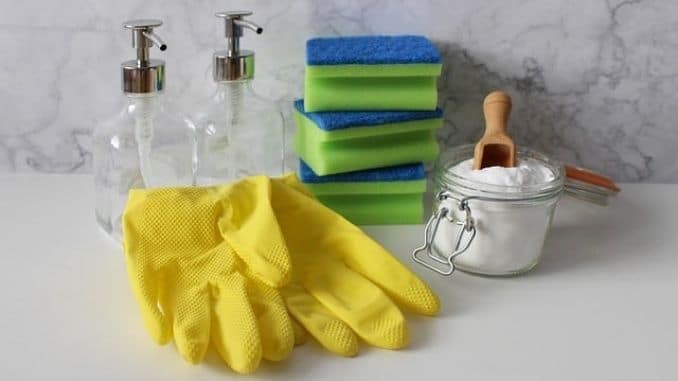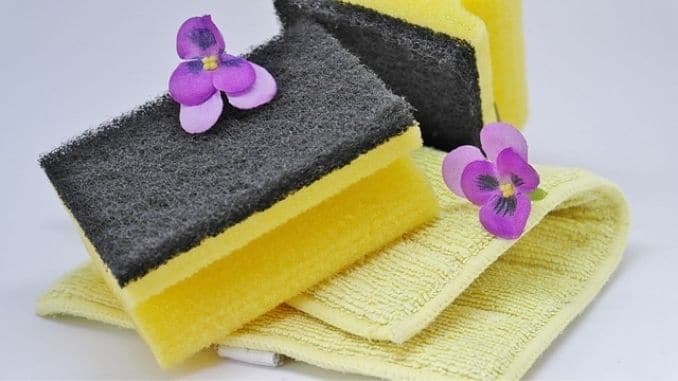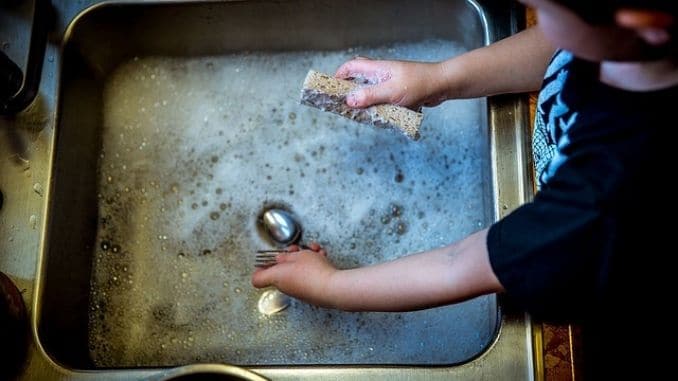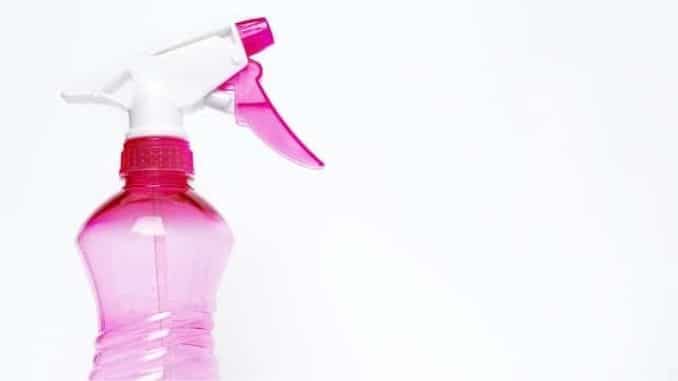
In 2010, researchers reported that women who used cleaning products frequently could be at a higher risk of breast cancer than those who used them sparingly.
The results of that study were shocking. We all knew it wasn’t healthy to inhale cleaning product fumes or allow the solutions to sink into our skin, but cancer?
The researchers acknowledged that their study didn’t prove that cleaning products caused cancer ― only that more women who had breast cancer recalled using more of these products.
Still, it’s concerning, particularly when you dig into the ingredients that are in some of these products — things like phthalates, quaternary ammonium compounds (QUATS), 2-butoxyethanol, phenols, unknown fragrance chemicals and more.
Fortunately, there are other options for cleaning, even for tough issues like those you find in the bathroom. Safer cleaning solutions can help you cut back or even eliminate your reliance on potentially unsafe chemical cleaners.
What’s Wrong With Chemical Cleaners?
For decades, we didn’t think we could harm ourselves by using household chemical cleaners, but some recent studies have caused us to rethink that assumption.
In addition to the study listed above, there was another one that came out in 2018 that added to the concern. Researchers analyzed data from more than 6,200 participants in the European Community Respiratory Health Survey. They were at an average age of 4 when they entered the study and then were followed for more than 20 years. Results showed that women who worked regularly as cleaners or regularly used cleaning sprays or other cleaning products at home. It seemed to experience a greater decline in lung function in time than women who didn’t clean. More specifically, when compared with women who didn’t clean.
The amount of air the participants could forcibly exhale in one second declined 3.6 milliliters (ml)/year faster in women who cleaned at home and 3.9 ml/year faster in women who worked as cleaners.
The total amount of air the participants could forcibly exhale declined 4.3 ml/year faster in women who cleaned at home and 7.1 ml/year faster in women who worked as cleaners.
The effects were comparable to the effect of 10 to 20 years of tobacco smoking.
The researchers described the level of lung impairment as surprising and speculated that it was caused by cleaning chemicals that irritated the mucous membranes lining the airways, resulting in persistent changes over time.
Again, this study didn’t prove that cleaning products caused lung problems ― only that their use was associated with them.
The American Lung Association warns that many cleaning supplies or household products can cause headaches, eye and throat irritation, and other health problems, “even cancer.” They add that some products release dangerous chemicals. It include volatile organic compounds (VOCs) and others that can contribute to chronic respiratory problems and allergic reactions.
They recommend avoiding air fresheners altogether, reading labels before buying household cleaning products and avoiding those with VOCs, fragrances and flammable ingredients. Moreover, they also suggest opening windows and doors when cleaning and checking the United States Environmental Protection Agency’s list of products that meet its Safer Choice requirements.
Meanwhile, you may want to consider safer cleaning options like the following.
How to Clean Without Chemicals
The first step in reducing your exposure to potentially dangerous household cleaners is to stock your home with the most common and useful non-toxic cleaning ingredients. Then, start using them either alone or in combination with one another to tackle most of your cleaning jobs around the house.
1. Vinegar
Vinegar is quite acidic, which means that it can break down dirt and grime and eliminate grease, soap scum and even hard water buildup. It’s effective yet gentle and won’t harm surfaces. It is important to remember not to mix it with bleach as that combination can create toxic fumes.
White vinegar is the best for cleaning as it’s the most acidic and won’t leave any color behind, but apple cider vinegar can also be used when you’re looking for a gentler option.
- Clogged drains: If you’ve got a slow drain, dump some baking soda into it, and then add twice the amount of vinegar. Proceed with caution as the mixture will fizz up, but that fizzing action will help break down hair and other debris in the drain. Flush with water and repeat if necessary.
- Hard water buildup: Using a 50:50 mix of vinegar and water, spray on hard water stains, let sit for about 15 minutes, and then use a brush to scrub the stain away and rinse. You can also leave the mixture overnight inside teapots, coffee makers and humidifiers with buildup inside, and then rinse the next morning.
- Dirty windows: Dilute vinegar with water and use it to clean windows. It will leave a streak-free shine.
- All-purpose: Fill a spray bottle with water, white vinegar and several drops of tea tree oil. Use to get rid of smells and to disinfect surfaces everywhere in your home.
2. Baking Soda
Baking soda is a mild, natural abrasive agent that helps clean and whiten at the same time. Because it’s abrasive, you can use it as a scrubber while enjoying its natural virus-killing properties. In fact, if you need to sanitize an area, choose baking soda as it cleans and disinfects while leaving behind a fresh smell.
- Cutting boards: Mix baking soda with equal parts salt and water to clean and disinfect both plastic and wooden cutting boards.
- Trashcans: Sprinkle some baking soda into the bottom of the trash bag to help battle odors.
- Tough stains: Mix up a batch of baking soda paste ― baking soda and water ― and use it to scrub off stains, particularly sticky grease and buildup above the stove.
- Carpet stains: Douse the area with vinegar, and then top with baking soda. Allow to dry and vacuum away.
3. Castile Soap
This is a type of soap that’s made with plant oils and alkali — no chemical detergents. It’s highly concentrated and powerful and can remove grime and bacteria from nearly all surfaces, yet it’s biodegradable. It’s been used for centuries and continues to be popular today as a general cleanser. Typically, you dilute it with water before using.
- Laundry detergent: Dissolve 3/4 cup baking soda and 1/4 cup salt into 2 cups of warm water. Pour into a gallon container. Add 1 cup of liquid castile soap. Fill to the top with water. Use about 1/4 cup per load. Not only will it clean your clothes, but it may also help them last longer since you’re not using harsh chemicals.
- Dishwashing detergent: Use the same mixture as you do for laundry detergent. Add one tablespoon to the open compartment of the dishwasher, and then add one cup of white vinegar to the closed department.
- Bathtub cleaning: Fill a spray bottle with 1/3 cup castile soap and 2/3 cup water. Spread baking soda around the tub, and then spray the mixture on top of it. Scrub and then rinse.
4. Lemon Juice
Natural lemon juice is also acidic, and it comes with a natural, pleasant scent, which makes it ideal for cleaning. It can cut through grease and shine hard surfaces and can also get rid of odors and some stains.
- Garbage disposal odors: Drop in a tablespoon or two of lemon juice each week in the garbage disposal side of the drain to keep the sink smelling fresh. You can also dump half of a real lemon in and turn the disposal on to provide a deeper clean.
- Dirty grout: Mix a couple of tablespoons of lemon juice with a couple of teaspoons of cream of tartar, then apply with a toothbrush. Let it sit for a few minutes, then scrub and rinse.
- Limescale: Scrub a healthy amount of lemon juice on and around your faucets with a toothbrush, leave overnight and rinse in the morning with a damp cloth.
5. Hydrogen Peroxide
This is a natural germ killer that works great as an antiseptic and bleaching agent. You can use it on almost anything that needs refreshing. It’s also ultra-cheap.
- Dirty refrigerator: Because hydrogen peroxide is non-toxic, you can use it on surfaces that store foods without worry. Take everything out of the refrigerator. Dilute some hydrogen peroxide with water in a spray bottle, then spray all of the inside surfaces and wipe clean.
- Dirty toilet bowl: Pour half a cup of hydrogen peroxide into the toilet bowl to sanitize it. Let stand for 20 minutes, and then scrub clean.
- Clothing stains: Pretreat with a hydrogen and water solution for a few minutes before tossing in the laundry. This works well for armpit stains too. Use a brush to scrub it in, and then let it sit for a few minutes before washing. Add a cup to your white load to boost brightness.
- Gross kids’ toys: Disinfect little kids’ toys with a hydrogen peroxide spray. Also, by dipping them into a sink filled with water and mixed with a small amount of hydrogen peroxide.
6. Essential Oils
Many naturally occurring plant compounds have germ-killing and freshening properties, making their essential oils great additions to your homemade cleaners. Add any of those that you enjoy to your other cleansers, and consider the following suggestions:
- Cleansing wipes: To create your own convenient cleansing wipes, mix 3 teaspoons of Castile soap. 50 to 75 drops of tea tree essential oil and 3 cups of vinegar together. Then use paper towels, reusable cloths or old T-shirts for your wipes. Dip into the mixture when you need it.
- Air purifier: Add a few drops of tea tree oil and/or other preferred oil to an oil diffuser to purify the air naturally without dangerous air fresheners.
- Disinfectant spray: Combine tea tree oils, eucalyptus oil, witch hazel, and water. Use it in a spray bottle to clean and disinfect surfaces like exercise equipment, remote controls, purses, doorknobs and more.
7. Cornstarch
Cornstarch is the starch derived from corn grain. It’s a common food ingredient and is frequently used to thicken sauces, gravies, and soups, but it can also work well as an inexpensive cleanser.
- Odor control: Cornstarch is extremely absorbent, making it ideal for zapping unpleasant odors. Sprinkle some in your stinky shoes and let them sit overnight, and then shake out. You can also freshen up stuffed animals by putting them into a plastic bag, coating them with cornstarch, and shaking well. Leave overnight. The next morning, shake it out well and then vacuum away the remaining starch.
- Grease stains: Apply a scoop of cornstarch to the stain and allow to sit for 12 hours. Wash normally.
- Silver polish: Mix up a paste of one part cornstarch and two parts water. Then use it to polish your silver.
- Wood polish: Mix equal parts cornstarch and water in a spray bottle. Spray wood surfaces lightly and wipe clean with a microfiber cloth.
For your guide to the best foods to heal your body, check out The Best Foods that Rapidly Slim & Heal in 7 Days, here!






